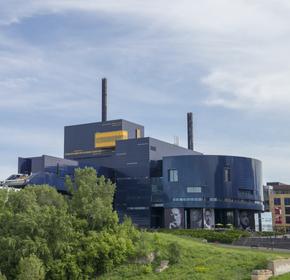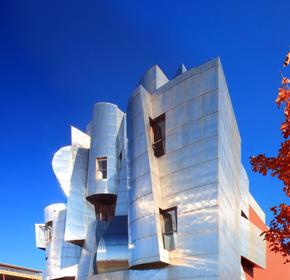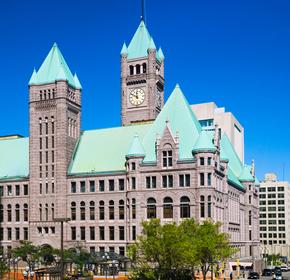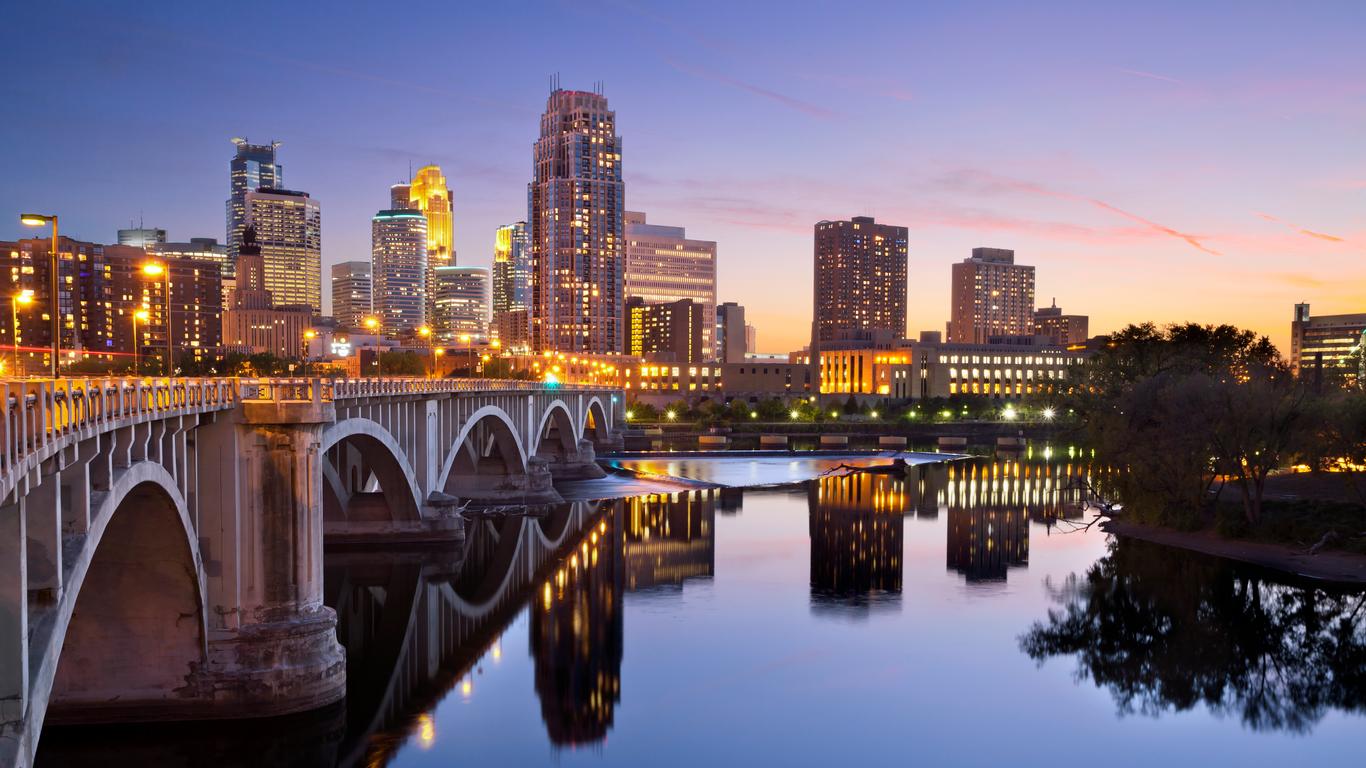
Minneapolis travel guide
Minneapolis Tourism | Minneapolis Guide
You're Going to Love Minneapolis
Minneapolis A.K.A Waterfall City, is a city of great food, sporting attractions, natural beauty, and cultural delights. In fact, it's the pearl of the north, and a destination that's easy to fall for.
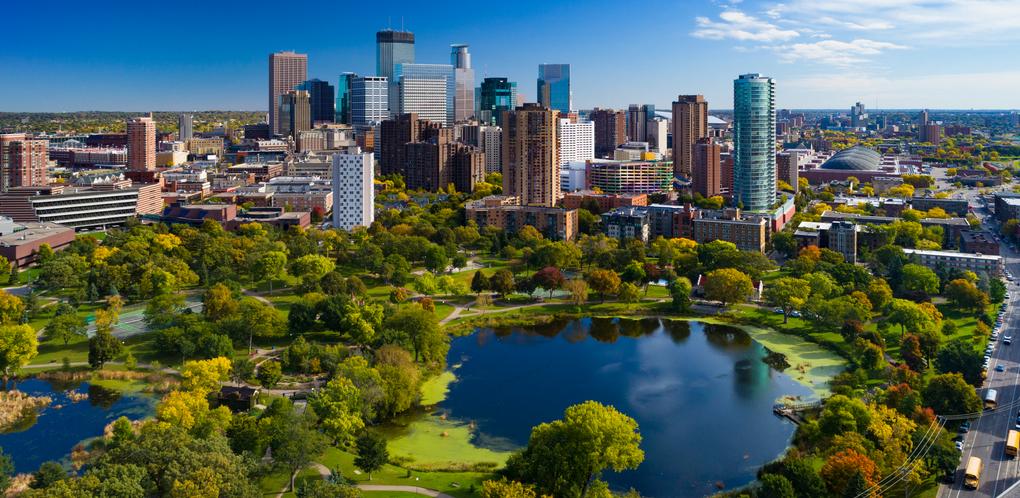
If if not the the cheesy Juicy Lucy burgers you become obsessed with, it might be the local beers from the Surly Brewing Co, it could be restaurants on Eat Street or the magical art collection at the Walker Art Center. Whatever it is that draws people in, Minneapolis is a city that keeps people coming back for more.
While it's not huge (around 400,000 people in all), this is a city with heart and soul. You can feel it at Target Field as the Twins get ready to bat. You can sense it in the parks and at the markets of Downtown. Minneapolis is special, and it could well be the ideal city break destination for you.
Top 5 Reasons to Visit Minneapolis
Food and Drink
If you love food, you'll love Minneapolis. From the Vietnamese, Chinese and German eateries of Eat Street to the daily farmers' market to the Greek and Scandinavian restaurants in North Minneapolis, dining out is a treat. And don't forget to try local delicacies like the cheese-filled Juicy Lucy burgers.
Sport
The Minnesota Twins are one of Major League Baseball's most popular teams, and Target Field is a fantastic place to visit. If the baseball season has ended, there's also the chance to watch the Vikings battle it out in the NFC North.
Art
Minneapolis is one of the north's cultural centers, with great theaters and music venues to explore. However, it's art that really shines in the Twin Cities. In the Walker Art Center, you'll find one of America's leading contemporary art collections, while places like the Soap Factory and All My Relations offer cutting edge work from the area's many local artists.
Nature
Minneapolis is one of the greenest cities in the USA. Play volleyball on the beach at Lake Calhoun, take a boat tour on the Mississippi River, kayak on Cedar Lake and swim at the secluded public beach at Lake Nokomis. No other city offers so many beautiful spots within walking distance of the center.
Shopping
Minneapolis is also a shopping center. In the middle of town, there are plenty of malls, not least the Nicollet Mall, which offers dining options and major brands to choose from. However, it's dwarfed by the Mall of America - the largest mall in the USA and a truly awesome experience. You won't even scratch the surface of what it has to offer in one visit, so set aside a couple of days to visit all of its wings and attractions.
What to do in Minneapolis
1. Minneapolis Institute of Arts: An Artistic Paradise
Located in the Whittier neighborhood, the Institute of Arts is a cornucopia of wonderful art. Spread over 32,000 square meters of gallery space, admission is completely free, and it's well worth paying a visit. When you do, you'll encounter a massive collection of 80,000 artefacts and artworks. An outstanding Asian art collection and striking modernist works by artists like Fernand Leger are just some of the attractions.
2. Guthrie Theater: One of the Mid West's Leading Drama Venues
South 2nd Street's Guthrie Theater was founded in 1963 and ever since it has been Minneapolis' foremost arts venue. Far from a stopping off point for Broadway companies, the Guthrie stands out thanks to its superb resident troupe, who perform a constantly changing program of contemporary and classic plays. Just to take a few examples from recent years: Romeo and Juliet, Ibsen's An Enemy of the People and a spellbinding version of Dickens' A Christmas Carol. So if drama is your passion, the Guthrie is a must-visit.
3. Minnehaha Park: An Inspiration to Poets
Minnehaha Park runs alongside the Mississippi in Longfellow Ward, named for the poet of the masterwork The Song of Hiawatha. In keeping with the Longfellow theme, it contains a model of the poet's home (he was from Massachusetts, by the way), but there's much more than historical curiosities to see. For one, there are the wonderful Minnehaha Falls, for which Longfellow named the character Minnehaha, Hiawatha's lover. Although the poet never actually saw the falls himself, you can beat him to it by visiting this lovely park, which also boasts miles of cycling trails, a 19th-century railway station and beautiful gardens.
4. Weisman Art Museum: A Gallery that's a Work of Art Itself
Just up the river bank from Minnehaha Park, the Weisman Art Museum makes a nice complement to the Institute of Arts. As soon as you see it, you'll either be impressed or, well, just surprised. With its daring Frank Gehry design, the Weisman is one of the world's most visually exciting galleries. Inside, the visual delights are just as impressive, including works by underrated American modernists like Alfred Maurer and a world-class collection of Korean Art.
5. American Swedish Institute: Scandinavia Brought to Central Minneapolis
Minneapolis welcomed thousands of Swedes in the 19th century and the Scandinavian nation still has a big influence on local food, drink and music. This institute on Park Avenue is the center for the entire Swedish-American population, telling the story of their migration and home country in what used to be the mansion of Swan Turnblad -- a Swedish immigrant who found his fortune in the USA. Nowadays, the well managed museum features Swedish design, exhibits on the Sami people of Lapland and stages a fantastic Christmas display showcasing how Scandinavians celebrate the festive season. Even if you have no Swedish heritage, it's a quirky and engaging place to visit.
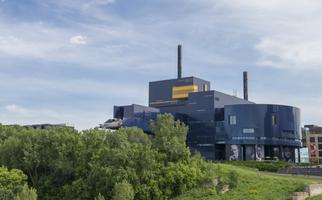

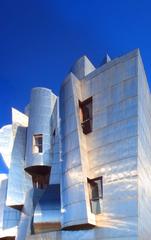
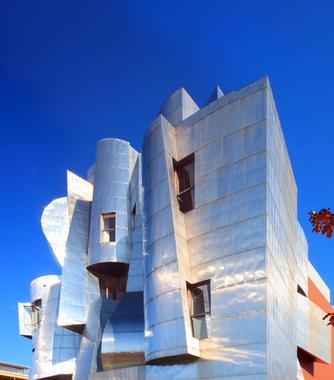
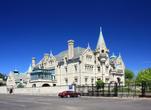
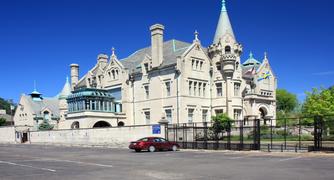
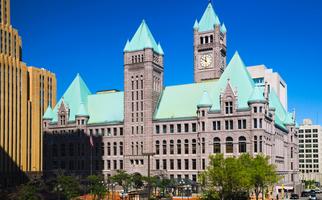
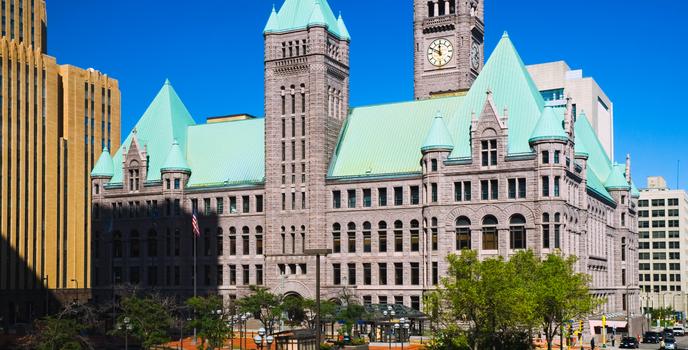
1. Minneapolis Institute of Arts: An Artistic Paradise
Located in the Whittier neighborhood, the Institute of Arts is a cornucopia of wonderful art. Spread over 32,000 square meters of gallery space, admission is completely free, and it's well worth paying a visit. When you do, you'll encounter a massive collection of 80,000 artefacts and artworks. An outstanding Asian art collection and striking modernist works by artists like Fernand Leger are just some of the attractions.
2. Guthrie Theater: One of the Mid West's Leading Drama Venues
South 2nd Street's Guthrie Theater was founded in 1963 and ever since it has been Minneapolis' foremost arts venue. Far from a stopping off point for Broadway companies, the Guthrie stands out thanks to its superb resident troupe, who perform a constantly changing program of contemporary and classic plays. Just to take a few examples from recent years: Romeo and Juliet, Ibsen's An Enemy of the People and a spellbinding version of Dickens' A Christmas Carol. So if drama is your passion, the Guthrie is a must-visit.
3. Minnehaha Park: An Inspiration to Poets
Minnehaha Park runs alongside the Mississippi in Longfellow Ward, named for the poet of the masterwork The Song of Hiawatha. In keeping with the Longfellow theme, it contains a model of the poet's home (he was from Massachusetts, by the way), but there's much more than historical curiosities to see. For one, there are the wonderful Minnehaha Falls, for which Longfellow named the character Minnehaha, Hiawatha's lover. Although the poet never actually saw the falls himself, you can beat him to it by visiting this lovely park, which also boasts miles of cycling trails, a 19th-century railway station and beautiful gardens.
4. Weisman Art Museum: A Gallery that's a Work of Art Itself
Just up the river bank from Minnehaha Park, the Weisman Art Museum makes a nice complement to the Institute of Arts. As soon as you see it, you'll either be impressed or, well, just surprised. With its daring Frank Gehry design, the Weisman is one of the world's most visually exciting galleries. Inside, the visual delights are just as impressive, including works by underrated American modernists like Alfred Maurer and a world-class collection of Korean Art.
5. American Swedish Institute: Scandinavia Brought to Central Minneapolis
Minneapolis welcomed thousands of Swedes in the 19th century and the Scandinavian nation still has a big influence on local food, drink and music. This institute on Park Avenue is the center for the entire Swedish-American population, telling the story of their migration and home country in what used to be the mansion of Swan Turnblad -- a Swedish immigrant who found his fortune in the USA. Nowadays, the well managed museum features Swedish design, exhibits on the Sami people of Lapland and stages a fantastic Christmas display showcasing how Scandinavians celebrate the festive season. Even if you have no Swedish heritage, it's a quirky and engaging place to visit.








Where to Eat in Minneapolis
Whether you want gourmet food or authentic American classics Minneapolis will have something for you. The first place to head is probably Eat Street in Downtown Minneapolis, where you'll find great Vietnamese restaurants like Quang and German eateries like the Black Forest Inn. Then, head to Matt's Bar in the south of the city for a Juicy Lucy. A speciality of Minneapolis, Juicy Lucy's are beef burgers that contain cheese inside two patties that have been molded together. And, if you are in Midtown, check out Mercado Central, which is the best place in town to find great Mexican food. A mid-range meal should cost around $13-18, while you can expect to pay more than $30 at up-market restaurants.
When to visit Minneapolis
The best time to visit the Twin Cities is during the summer, which lasts from June through to early September. Most visitors avoid traveling in the winter months, which are usually bitterly cold, although, with the Skyways network and plenty of winter-friendly attractions, there's still plenty to do. However, to see the Mississippi in all its glory and enjoy the city's walking tours, book a trip in July or August, when the sun shines, and the whole city is open for business.
How to Get to Minneapolis
Plane
The best way to get to Minneapolis by air is by touching down at Minneapolis-Saint Paul International Airport. From there, getting into town is simple. Just take the Blue Line on the Minneapolis light rail network, which costs between $1.75 and $2.25.
Train
The city's train station is actually in neighboring St Paul, but is connected to Minneapolis via the Green Line of the light rail system. It connects the city with western destinations like Portland and Seattle, as well as Chicago to the east and the rest of the Amtrak network.
Car
I-94 connects Minneapolis by road with destinations to the west like Seattle, Boise, and Portland, while I-35 runs to the south through Kansas City to Texas. From Chicago, take I-94 straight to Minneapolis, while those coming from California can take I-80 or I-76 and switch onto I-35.
Bus
Intercity Greyhound and Jefferson Lines buses arrive at the Hawthorne Transportation Center in the Downtown area, and provide connections to most parts of the USA. Badger coaches links the city with Milwaukee and Madison while Megabus offers low-cost fares from Chicago and other major cities.
Airlines serving Minneapolis
Where to stay in Minneapolis
Downtown – If you want to attend business meetings, club into the small hours or visit Minneapolis' main shopping areas, Downtown is the place to stay. One of the striking things about Downtown Minneapolis is the 7-mile Skyway network, which links the major offices, theaters, transport hubs and stores (and offers handy respite from the winter chill). Downtown is also home to Target Field (home of the Twins) and the Metrodome (home of the Vikings in the NFL).
Popular Neighborhoods in Minneapolis
Southeast – Home to the University of Minnesota, Southeast Minneapolis is a relaxed place to spend time. It's also where you'll find Dinkytown, a tightly packed area of restaurants and cafes, including some of Minneapolis' best eateries like the Vietnamese restaurant Camdi and the Loring Pasta Bar.
Northeast – An elegant area filled with Victorian buildings, Northeast Minneapolis has recently started to become the city's most creative, happening district. It hosts the Art-A-Whirl festival in May and has plenty of architectural highlights, including the huge Grain Belt Brewery Complex, now a luxury housing development. There's lots of green space to enjoy as well, making the area an appealing base for a summer vacation.
Where to stay in popular areas of Minneapolis
Most booked hotels in Minneapolis
How to Get Around Minneapolis
Public Transportation
Buses are an excellent way to get around town during the day, but coverage drops dramatically in the evenings. The MetroTransit light rail network is also very handy, with stops at locations like the Mall of America and Target Field. Day passes cost just $6 for both buses and light rail, and a single journey costs $1.50.
Taxis
Cabs in Minneapolis have a basic flag drop of $2.50, then $2.50 per mile after that point, with a minimum charge of $5. Uber is active in the city and their cheapest vehicles charge $0.45 as a meter drop, then $1 per mile after that point.
Car
Having a car can be a big advantage in Minneapolis particularly if you intend to venture out of town to the suburban malls. You'll find most major rental companies represented at the airport, including Hertz and Enterprise, and can expect to pay around $25 per day to rent a medium sized car. Parking space is ample in the city center, but look out for one-way streets, especially around Hennepin Avenue, and try to avoid driving into or out of town during rush hour.
Best car hire deals in Minneapolis
Standard
5 Adults, 3 Bags
S$ 58/day
Supplier choice
5 Adults, 5 Bags
S$ 61/day
The Cost of Living in Minneapolis
Shopping Streets
Shopping is one of the highlights of a trip to Minneapolis and visitors with money to burn have plenty of options. The most famous mall in the area is Mall of America, located in suburban Bloomington. The largest mall in the USA, there's something for everyone, including branches of Macy's, Nordstrom's and Old Navy. Back in town, the major shopping center is the pedestrianized Nicollet Mall in Downtown. It's a great place to shop at major chains like Macy's and stop for a bite to eat at restaurants like Fogo de Chao Brazilian Steakhouse.
Groceries and Other
If you need to shop for groceries, Minneapolis offers plenty of choice. In the Downtown area alone, there are a number of Whole Foods stores, along with plenty of Cub Foods outlets. There's even a farmers' market on East Lyndale Avenue that is open every day of the week. Food costs shouldn't be too high. A gallon of milk costs around $3, and a pound of apples is $2.35 - cheap by the standards of many US cities.
